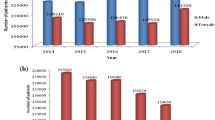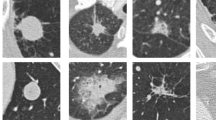Abstract
A low false positive (FP) rate is of great importance for the use of a Computer Aided Detection (CAD) system to detect pulmonary nodules in thoracic Computed Tomography (CT). However, due to the variations of nodules in appear and size, it is still a very challenging task to obtain a low FP rate. In this paper, we propose a deep Convolutional Neural Network (CNN) based transfer learning method for FP reduction in pulmonary nodule detection on CT slices. We utilized one of the state-of-the-art CNN models, VGG-16 [4], as a feature extractor to obtain nodule features, and used a support vector machine (SVM) for nodule classification. Firstly we transferred all the layers from a pre-trained VGG-16 model in ImageNet to our target networks. Then, we tuned the last fully connected layers to adjust the computer-vision-task-trained CNN model to pulmonary nodule classification task. The initial CNN filter weights were then optimized using the training data, i.e., the pulmonary nodule patch images and corresponding labels through back-propagation so that they better reflected the modalities in the pulmonary nodule image dataset. Finally, features learned in the fine-tuned CNN were used to train a SVM classifier. The output of the trained SVM was used for final classification. Experimental results show that the overall sensitivity of the proposed method was 87.2% with 0.39 FPs per scan, which is higher than 85.4% with 4 FPs per scan obtained by other state of art method.

Similar content being viewed by others
References
Bar Y, Diamant I, Wolf L, and Greenspan H (2015) Deep learning with non-medical training used for chest pathology identification, in Proc. SPIE Med Imag, 94 140V–94 140V
Camarlinghi N (2013) Automatic detection of lung nodules in computed tomography images: training and validation of algorithms using public research databases. Eur Phys JPlus 128(9):21
Dhara AK, Mukhopadhyay S, Khandelwal N (2012) Computer-aided detection and analysis of pulmonary nodule from CT images: a survey. IETE Techn Rev 29(4):265–275
Farag A, Ali A, Graham J, Farag A, Elshazly S, Falk R (2011) Evaluation of geometric feature descriptors for detection and classification of lung nodules in low dose CT scans of the chest. In: 2011 I.E. international symposium on biomedical imaging: from nano to macro. IEEE, 169–172
Gao M et al. (2015) Holistic classification of CT attenuation patterns for interstitial lung diseases via deep convolutional neural networks. In: 1st Workshop Deep Learn. Med. Image Anal., Int. Conf. Med. Image Comput. Comput. Assist. Intervent., Munich, Germany, [Online]. Available: www.research.rutgers.edu/~minggao/files/MingchenGao_MICCAIworkshop2015.pdf
Girshick R, Donahue J, Darrell T, Malik J (2014) Rich feature hierarchies for accurate object detection and semantic segmentation. In: 2014 I.E. Conference on Computer Vision and Pattern Recognition (CVPR), IEEE, pp. 580–587
Girshick R, Donahue J, Darrell T, Malik J (2016) Region-based convolutional networks for accurate object detection and semantic segmentation. IEEE Trans Pattern Anal Mach Intell 38(1):142–158
Jiang H, Ma H, Qian W, Gao M, Li Y (2017) An automatic detection system of lung nodule based on multi-group patch-based deep learning network. IEEE J Biomed Health Inform. https://doi.org/10.1109/jbhi.2017.2725903
Khan A, ElDaly H, Rajpoot N (2013) A gamma-gaussian mixture model for detection of mitotic cells in breast cancer histopathology images. J Pathol Inf 4(1)
Krizhevsky A, Sutskever I, Hinton GE (2012) Imagenet classification with deep convolutional neural networks. Adv Neural Inf Process Syst:1097–1105
Kumar D, Wong A, Clausi DA (2015) Lung nodule classification using deep features in CT images[C]// conference on computer and robot vision. IEEE Comput Soc 133–138
LeCun Y, Bengio Y, Hinton G (2015) Deep learning. Nature 521:436–444
Li F, Arimura H, Suzuki K, Shiraishi J, Li Q, Abe H, Engelmann R, Sone S, MacMahon H, Doi K (2005) Computer-aided detection of peripheral lung cancers missed at CT: ROC analyses without and with localization. Radiology 237:684–690
Liang MZ, Tang W, Xu DM, Jirapatnakul AC, Reeves AP, Henschke CI, Yankelevitz D (2016) Low-dose CT screening for lung Cancer: computer-aided detection of missed lung cancers. Radiology 281(1):279–288
Liu J-K et al (2017) An Assisted Diagnosis System for Detection of Early Pulmonary Nodule in Computed Tomography Images. J Med Syst 41:30
Lu L, Tan Y, Schwartz LH et al (2015) Hybrid detection of lung nodules on CT scan images. Med Phys 42(9):5042–5054 20
Margeta J, Criminisi A, Lozoya RC, Lee DC, and Ayache N (2015) Fine-tuned convolutional neural nets for cardiac MRI acquisition plane recognition. Comput Methods Biomech Biomed Eng, Imag Vis 1–11
Roth H et al. (2014) A new 2.5D representation for lymph node detection using random sets of deep convolutional neural network observations. In: proc. MICCAI, P. Goll, N. Hata, C. Barillot, J. Hornegger, and R. Howe, (eds.), vol. 8673, LNCS, pp. 520–527,
Setio A et al (2016) Pulmonary nodule detection in CT images using multi-view convolutional networks. IEEE Trans Med Imag 35(5):1160–1169
Simonyan K, Zisserman A (2014) Very Deep Convolutional Networks for Large-Scale Image Recognition ArXiv, [Online]. Available:arXiv:14091556
Sivakumar S, Chandrasekar C (2013) Lung nodule detection using fuzzy clustering and support vector machines. Int J Eng Technol 5(11):179–185
Society, AC (2016) February 8, 2016 [cited 2016 February 28, 2016]; Available from: http://www.cancer.org/cancer/lungcancer-non-smallcell/detailedguide/non-small-cell-lungcancer-key-statistics
Song Y, Cai W, Zhou Y, Feng DD (2013) Feature-based image patch approximation for lung tissue classification. IEEE Trans Med Imaging 32(4):797–808
Sorensen L, Shaker SB, De Bruijne M (2010) Quantitative analysis of pulmonary emphysema using local binary patterns. IEEE Trans Med Imaging 29(2):559–569
Suzuki K (2012) Pixel-based machine-learning in medical imaging. Int J Biomed Imaging 2012: article ID 792079, 18 pages
Suzuki K (2013) Machine learning in computer-aided diagnosis of the thorax and Colon in CT: a survey. IEICE Trans Inf Syst E96-D:772–783
Suzuki K (2017) Overview of deep learning in medical imaging. Radiol Phys Technol 10(3):257–273
Suzuki K (2017) Machine learning in medical imaging before and after introduction of deep learning. J Med Imaging Inform Sci 34(2):14–24
Suzuki K (2017) Survey of deep learning applications to medical image analysis. Med Imaging Technol 35(4):212–226
Suzuki K, Armato SG III, Li F, Sone S, Doi K (2003) Massive training artificial neural network (MTANN) for reduction of false positives in computerized detection of lung nodules in low-dose computed tomography. Med Phys 30(7):1602–1617
Szegedy C, Liu W, Jia Y, Sermanet P, Reed S, Anguelov D, Erhan D, Vanhoucke V, Rabinovich A (2015) Going deeper with convolutions. In: IEEE, CVPR pp. 1
Tajbakhsh N, Lian J (2015) Computer-aided pulmonary embolism detection using a novel vessel-aligned multi-planar image representation and convolutional neural networks. In: Proc MICCAI
Tajbakhsh N, Suzuki K (2017) Comparing two classes of end-to-end learning Machines for Lung Nodule Detection and Classification: MTANNs vs. CNNs. Pattern Recogn 63:476–486
Tajbakhsh N, Gurudu SR, and Liang J (2015) A comprehensive computer-aided polyp detection system for colonoscopy videos. In: Information processing in medical imaging. New York: Springer, pp. 327–338
Tajbakhsh N, Gurudu SR, and Liang J (2015) Automatic polyp detection in colonoscopy videos using an ensemble of convolutional neural networks. In; Proc. IEEE 12th Int Symp O Biomed Imag, pp. 79–83
Valente IRS, Cortez PC, Neto EC, Soares JM, de Albuquerque VHC, Tavares JMR (2016) Automatic 3D pulmonary nodule detection in CT images: a survey. Comput Methods Prog Biomed 124:91–107
Vedaldi A and Lenc K (2014) Matconvnet – convolutional neural networks for matlab. CoRR, abs/14124564
Xu Z, Mei L, Liu Y, Hu C, Chen L (2016) Semantic enhanced cloud environment for surveillance data management using video structural description. Computing 98(1–2):35–54
Ye J, Ding Y (2018) Controllable keyword search scheme supporting multiple users. Future Generation Comp Syst 81:433–442
Zhang J, Xia Y, Xie Y, Fulham M, Feng DD (2017) Classification of medical images in the biomedical literature by jointly using deep and handcrafted visual features," IEEE journal of biomedical and health informatics, available online 20 November 2017. https://doi.org/10.1109/JBHI.2017.2775662
Zhang J, Xia Y, Cui H, Zhang Y (2018) Pulmonary nodule detection in medical images: a survey. Biomed Signal Process Control 43:138–147
Zheng Y, Liu D, Georgescu B, Nguyen H, and Comaniciu D (2015) 3D deep learning for efficient and robust landmark detection in volumetric data. In: Proc. MICCAI, pp. 565–572
Acknowledgments
This work was supported in part by a grant from the National Natural Science Foundation of China (No. 61202198, No.61401355), a grant from the China Scholarship Council (No.201608610048) and the Nature Science Foundation of Science Department of PeiLin count at Xi’an(GX1619), the Key Laboratory Foundation of Shaanxi Education Department, China (No.14JS072). The authors gratefully acknowledge the helpful comments and suggestions of the reviewers.
Author information
Authors and Affiliations
Corresponding authors
Rights and permissions
About this article
Cite this article
Shi, Z., Hao, H., Zhao, M. et al. A deep CNN based transfer learning method for false positive reduction. Multimed Tools Appl 78, 1017–1033 (2019). https://doi.org/10.1007/s11042-018-6082-6
Received:
Revised:
Accepted:
Published:
Issue Date:
DOI: https://doi.org/10.1007/s11042-018-6082-6




